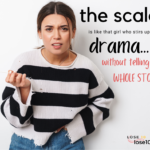Often people come up to me after a speaking engagement and share enthusiastically about how the presentation motivated them to make positive changes for their health. But, there are always a few folks whose comments indicate the need for a mindset adjustment towards more of a “can-do” attitude.

Similar to seeing this glass either half-empty or half-full, one can attend a motivational talk and see it as a springboard for change, or conversely, as an opportunity to dwell on what feels impossible to change.
After I speak at an event, I usually have at least one person tell me what they would do, but can’t do:
“I would eat healthy if I didn’t have food allergies.”
“I would exercise if my knee didn’t hurt.”
“I would play active sports, but I don’t like the cold.”
“I would eat better, but healthy food is too expensive.”
“I would go to the gym, but they cancelled my favorite class.”
“I would wake up earlier and pack my lunch, but I stay up late watching…”
“I would have finished your 52-day Countdown, but my partner quit.” (That’s my favorite.)
“I would focus more on my marriage, but I can’t get a babysitter for a date.”
I bet you can think of a solution for moving forward regardless of each obstacle noted. If I’m honest with you, I’m tempted to say, “Oh no worries, there are people who work in the cold outside all day, who bring their lunch free of allergens to work, focus on upper-body/core workouts when knees hurt, and play cards with their spouse for a date-night when low on funds.”
I admit that response probably wouldn’t help if they are stuck in the mindset where success feels impossible, right? My goal is to help shift them instead towards a #progressnotperfection mindset — towards a “I can’t do _______, but can do something” attitude.
I get it. There are things I can’t do, too. I can’t ride a bike. Not ever. My kneecap goes off track and instantly swells up if I do. I remember the last 2 times I tried and it was bad news both times: I promised myself I would just never do it again.
To be honest, it makes me sad if I think about it for long because I love active outside time with my kids and hubby and friends…especially at the beach. But biking is something I simply cannot do because of the way my knee tracks when cycling.

I went to the beach for one last hurrah for Fall Break last week. Everyone had bikes and was ready to go down the strip to get some homemade beachfront ice cream. Hmm…should I stay home? Should I drive the mile and a half down there to meet them? Or should I just put on my running shoes and run alongside them?
I chose the latter – running is something I CAN DO, and thanks to all the stoplights at each block, I could catch up with them when needed…wheels are faster than legs! (This is when HIIT training comes in handy.)

I think next time I get the “I would, but” response, I will say: “I agree that life is hard, that’s why they say ‘Choose your hard.’ You are welcome to vent briefly, as long as you can tell me what you CAN DO at the end of the vent. Deal?” (Do you think I could pull this response off gracefully? It really is something we all need to hear at times!)
Research shows that most meaningful progress happens by way of baby steps and meeting one short term goal followed by the next short term goal. So, the big question is, what CAN you do?
- What can you do to adjust your mindset so that your natural response is, “well, here’s what I can do?”
- What’s the first baby step in that direction?
- What is your first short-term goal? Second short-term goal?
- What will it look/feel like when you reach your final goal?
Remember, #progressnotperfection. Do what you CAN DO today, and then tomorrow, and then the next day. You’ll be much closer to your goal this time next month than if you wait and think about what you can’t do. (Yep, I’m serious enough about progress to make a tank top about it!)





